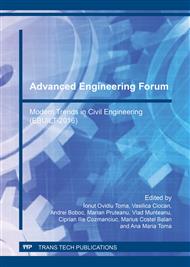p.573
p.581
p.587
p.596
p.602
p.609
p.619
p.624
p.632
Modern Technologies to Achieve Social Housing from Environmentally Friendly Materials
Abstract:
In an era when the economic crisis is coupled with the immigrants crisis thus exponentially increasing the number of those who need social assistance the need of living spaces is increasingly more. Building of such areas requires a high consumption of resources without fully addressing the requirements of comfort and efficiency. The Life cycle assessment of the product LCA is an environmental management technique that identifies flows of materials, energy and waste of a product during a product life-cycle management and environmental impact. Life cycle assessment (LCA) models the complex interaction between a product and the environment from cradle to grave. It is also known as life cycle analysis or ecobalance. Even though the LCA methodology is applied in building social housing there are few studies which analyze its impact on the construction phase of design, production, use and post- use as well as how the use of precast technology would meet LCA. The study aims is to identify those technologies and building materials that meet both the increasing requirement of achievement of cheap social housing but also meet the quality and environment standards. In this context the LCA (Life-cycle assessment), help us to develop a new methodology which consider the concept of housing as a product made from organic materials, cheap, easy to put into practice, which retain their value over the life of the building with minimal intervention during operation, and when the demolition occurs, the used materials can be exploited with low power consumption and without harming the environment.
Info:
Periodical:
Pages:
602-608
Citation:
Online since:
March 2017
Authors:
Keywords:
Price:
Сopyright:
© 2017 Trans Tech Publications Ltd. All Rights Reserved
Share:
Citation:


